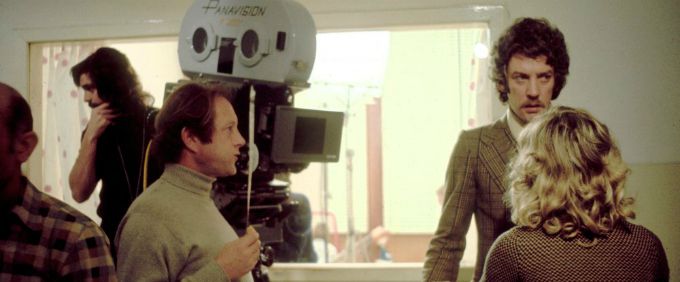Nicolas Roeg’s work is full of sex and death and the colour red. In fact, for Nicolas Roeg this seems to be all the same thing. You could maybe make a toxic paste out of the mix, pass it through a sausage machine, and use the resulting product as the filling for a particularly raucous sandwich. This is Roeg’s heady metaphysics, and one which David Thompson’s documentary NICOLAS ROEG: IT’S ABOUT TIME lustily wades into.
I first came to Roeg’s work via DON’T LOOK NOW when our GCSE English teacher whispered “I’m not meant to show you this sex scene, but let’s watch it anyway”. He then proceeded to stand at the back of the room and pant so heavily you could hear it above the soundtrack. I then came across his brilliant WALKABOUT with its heady array of cut-glass English accents, raw animal death and yonic tree formations. Roeg is the producer of dark, uncompromising and guilty work that never allows its audience to simply sit back and enjoy without demanding a pound of flesh in return. You are always somehow implicated in his dark unravelings, always complicit. He is also one of those directors that you realise has always lurked somewhere in your experience of cinema, even if you’re not instantly able to place his name. Roald Dahl fans will surely be familiar with his incredible adaption of THE WITCHES, for example, which left many childhoods deliciously rattled by his creature effects and brutal suspicion of youthful innocence.
As Jenny Agutter comments in the documentary, Roeg isn’t interested in moralising. The particular strength of WALKABOUT, in which Jenny Agutter’s teenage character is left to roam the Australian outback with her younger brother alone until she meets an aborigine, lies in its inhabiting of a space in which desires and fantasies are left to roam unchecked. The aforementioned yonic foliage surrounds the two young protagonists, urging them to fully embrace their nomadic placelessness, forget their origins and give in to destructive pleasures.
He’s a bit of a witchdoctor in this sense…
The documentary comprises a brilliant array of memories and stories from both Nicolas Roeg himself and the vast array of filmmakers and actors his work has influenced and been influenced by. Extensive behind-the-scenes footage and photographs show Roeg’s slow rise from unschooled cameraman, to visionary director of photography, to screenwriter and director. As Roeg sits at home in his study, smiling back through his career, he is every bit the quiet rockstar. David Bowie attests to the director’s nerve, as do fellow directors who recall how Roeg was always prepared to fight for his films, and how he always remained fearless when tackling difficult, unsettling material.
The complexity of Roeg’s life and career is told through an intriguingly simple program. Whilst one large segment of the documentary focuses on the director’s use of time – slow-motion, reversal, flashback – whereas another takes colour as its theme. Central is Roeg’s obsession with the image, his temporal and visual manipulations seeming geared not to change or enhance the image, but to further unlock something that had been present all along, releasing its anarchic potential. He’s a bit of a witchdoctor in this sense: a director to go to not necessarily because you think he’ll cure you, but because you’re interested to see how he might play with your wounds.
httpvh://www.youtube.com/watch?v=3x186dbPIoM


